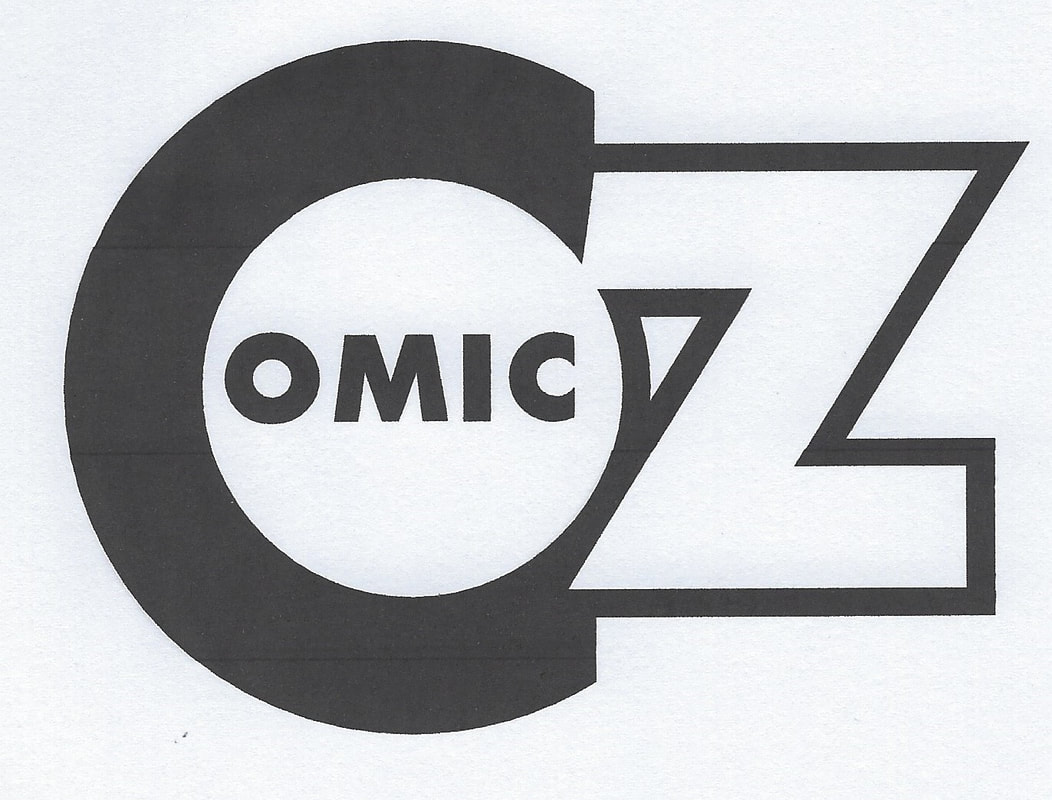|
What is the state of the local comic "industry"?
It is a question I often ask myself. Comics, as a medium, are a wonderful and unique means of communication and entertainment. Do they have to be economically viable for them to survive? In the 1940s and 1950s, comic sales (in this country, at any rate) were around the 80,000 copy mark -- per issue! Admittedly, that was partially due to the fact there were limited forms of mass entertainment then, and the banning of the US comic books certainly helped sales along. By the 1980s, sales of newsagent released comics were between 2 to 3,000 copies sold (per issue), and with a 10,000 print run that made them viable. (I am basing my figures on my Air Hawk comic book of the time.) These days, in the new century, there are even fewer newsagent-released comics. (I am not going to count The Phantom, or Mad Magazine or the other smaller digest books available, mainly because I see them as licenced products of overseas owners.) I understand that there are even more alternative means of entertainment available for people these days, that people do not visit the newsagents to purchase magazines as they once did... Yet, many people are still reading and making comics. There are more comic shops springing up around the country than ever before. Movies and TV series are being made about some of the comics (including, pleasingly, an animated TV series based on the Australian comic The Deep). Attending all the Supanova conventions over the past two years, I notice that there are many more people making and selling their own comics. Next week (Tuesday), I am due to give a free comic and Zine workshop to the public (with Jeremy Staples at The Edge in the Cultural Centre, at Southbank in Brisbane) and the event is booked out. So, there is still an interest in the medium that indicates it is very much alive. So, how to make them a viable proposition in Australia? I have had three issues of Oi Oi Oi! on sale in newsagents around the country in the past twelve months. While I am still waiting on the sales results for the Third Issue, I have to be honest and say that the sales of the first two issues of Oi Oi Oi! have been really disappointing. There were few media willing to carry copy about the launch (and all of those that did were on-line; no mainstream media touched the story, despite media releases and sample copies being sent to them). Given the growing grassroots appeal of comics at the conventions, made me think that this might translate into sales around the country in the newsagents. Sadly, it was not to be. Yet, there is still a need for the medium within Australia; and there are certainly the local artists and cartoonists who are seeking a vehicle for their craft. The Distributor has allowed me the opportunity to release an annual Summer Holiday edition of Oi Oi Oi! (with a four months sale period), which is really great. In the meantime, I am seeking ways of continuing the sequence of the magazine in a more grassroots manner to alert people of its existence. Do comics have to be economically viable for them to survive? From my perspective, Oi Oi Oi! does: I do not have deep enough pockets for it not to. And even though the first two (and possibly third) issues have not produced a profit, I am going to soldier on for the time being. Issue Four will be available from Australian comic shops and via subscription. The enthusiasm of people like Matt Emery (who has distributed it throughout Melbourne) and Vince Steele (even though he was/is disappointed with some of the content) and the subscribers make the losses to date more palatable at least. Yesterday, I completed preparation of Issue Five for Ryan (our interior design guy) and from there it is off to the printer. That issue will be available to co-incide with the Copier Jam! Exhibition at the Childers Festival in July. (More of that later.) I had hoped to get to Sydney's Supanova (as part of my beloved Australian Cartoonists' Association stand) to further publicise and sell more copies of Oi Oi Oi!, but my other comic book publishing schedules may yet prevent me from doing that. And that's another story...! Not everything I post on this Blog pertains to Comicoz doings. Here's an event for next Sunday that I truly would and should if I could (but cannot) go to...run by our friends from the Australian Cartoon Museum. There's a link (and another here). So you cannot go, at least check out their web-site. If you can go, please let me know what it was like, and make me incredibly jealous in the process...
This posting is for all the loyal readers of this Comicoz Blog who do not rely on Facebook postings or don't follow me on Twitter to learn of the latest news. You are now in the know, with this exclusive bit of information! Comicoz is presently actively seeking printing quotes to reproduce this graphic novel: Joe Shuster. In the next week Comicoz will be signing a contract with the copyright holders to release this book exclusively to the Australian market. The book will be initially released as a numbered limited edition high-quality hardcover book, and later offered as a trade paperback. This graphic novel is Comicoz' first foray into an international product. It has been written by New York-based Julian Voloj and illustrated by talented Sydney-sider Thomas Campi. But enough talking from me: it's time you read some samples pages from the book. Feel free to share this web-site, as you tell all your friends you were the First to know... [Dear Editor,]
Thank you for the most generous space allowed the late John Dixon in yesterday's newspaper. Whilst I understand your need to edit some sections, I was disappointed that your included material that was not in my submission, given that my writings had been approved by John's family. John was always embarrassed by his artistic contribution to Biggles (as well as his Catman stories run by Frew), mostly because they were properties owned by others at a time he was seeking to strike out on his own. It was the reason I wrote: "Although he worked on other characters...." Still, I can see that that information would be of interest to the general public. However, from a historical perspective, they were done earlier in his career (before Air Hawk); your editing gives the impression they were done later in his life. Perhaps I should have asked for your final copy pre-publication? I acknowledge that I am the publisher of "John Dixon's Air Hawk Magazine" from 1988 to 1990, but I am also -- more recently -- the publisher of two books on John Dixon and Air Hawk (2011 and 2013), with a third planned later this year. I'll send you one when it's published, if you'd like; lest you feel I harbour any resentment. Kind Regards, Nat. Karmichael. No sooner had I entered Comicoz' Bold Ben Hall plans on this web page, than I was informed about a new beaut movie being made about ... "The Legend of Ben Hall"! How co-incidental is that! The film's writer and director, Matthew Holmes, has kindly allowed the Trailer to be posted on this web-site. Thanks, Matthew! The movie "promises to be an action spectacular and a powerful drama, with attention to historic details rarely seen in Australian films" and is planned for release later in the year. If you want to see more (and how can you not?), you simply need to click here....
Just to share with you that work has just begun on the sequel to Monty Wedd's Ned Kelly work! Bold Ben Hall was the next biography undertaken by Monty. Just to give you an insider's look at the task ahead... Above, is a scan of the original artwork and below, a scan of the same page at the same size as it appeared in the newspapers of the day (pictured is the eighth episode dated 4th September 1977). Yes! Each and every original piece of artwork has been located and will be used for this project! What makes this an even more daunting undertaking than Ned Kelly, is the volume of the material to work with. While Ned Kelly, the bushranger, is perhaps better known than Ben Hall in the minds of everyday Australians, in the world of Monty Wedd's artistic career, this was a major component of his oeuvre: the adventure strip first saw print on 17th July 1977 and ran until 10th February 1985! (With only two one week breaks!) Let me put that in more simpler terms: Ned Kelly ran for 146 episodes; Bold Ben Hall ran for seven and a half years or 392 episodes! The reproduction of Bold Ben Hall at newspaper size would make it a most difficult read: most newspapers printed it at about 19 cm x 13 cm (or thereabouts). The original art (for the piece detailed above) is 50 cm x 38 cm and too unwieldy to be read comfortably as a book. SO, a decision has been made to make the resultant book a companion piece to Ned Kelly. While the number of pages will be far greater, the size of the book will remain the same (that's about 36 cm x 26 cm). Here is just some of the material in my office that I shall have to go through to bring this book to life! Ah, it's a tough gig, but somebody had to do it! One thing that has been a revelation this time, besides being able to work with all of Monty's original artwork, is also being able to work with Monty's original photocopies and seeing the various corrections he put in place. Not that these corrections are many, but does it gives an insight into his work and his work ethic. Some of them are where he has made a spelling error or he is unhappy with his own artwork (where notes in the margin read "Fix" or "Fix this"), or like the one illustrated below (from Episode 9 of 11th September 1977), where Monty has obviously corrected an inaccuracy. It wasn't the Boro River...it was the Bolo Creek. 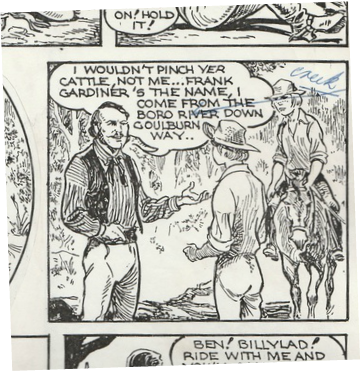 The copyright to all material in this posting belongs to The Family of Monty Wedd. Thanks to them for allowing this reproduction and the project to go ahead.... The copyright to all material in this posting belongs to The Family of Monty Wedd. Thanks to them for allowing this reproduction and the project to go ahead.... Would the change have changed the storyline? Not one iota! Why was it important? In the scheme of things, you wouldn't think it was. But to me, as a researcher of Australian comics, this example shows to me the detail Monty took to make his work as accurate as he could ....with even the little things. Now, that leads to other questions! As a publisher, which version do I publish? Do I run with the corrected version as documented on the bromides, as the newspapers received their copies? Or do I run with the original artwork without the correction? As I said, it is a tough gig! I'll keep you posted as to it's progress in the months ahead....! Born Newcastle (New South Wales) February 20th 1929
Died Bonsall (California) May 7th 2015 John Dangar Dixon was born on February 20th 1929 in Newcastle, New South Wales the youngest of three children. As the only boy, it was always expected of John that he carry on the family tradition of becoming an engineer, a surveyor or an adventurer. His Great Grandfather, Robert Dixon, had been one of the first white men to explore the Goulburn Plains in the early 1800s, and a copy of Robert’s original plan to lay out the city of Brisbane (on March 24th 1840) remains in the John Oxley Library.[1] John Dixon, however, always wanted to be a comic book or comic strip artist. As a schoolboy at East Kempsey Primary School, John was fascinated by the Sunday colour comics and fell under the spell of the works of the American masters of the craft, Alex Raymond, Hal Foster, and most particularly Milton Caniff. His father, a strict school headmaster at Stockton when John attended Newcastle High School, would have none of it. Comic artists were, after all, the worst kind of artists: the creators of literature that were forbidden from his father’s classrooms. So young John Dixon received no formal art training. On December 7th 1941 – Pearl Harbour! The War had a startling and sudden impact on young people’s lives. American comics had become a recent and popular entertainment medium, but their importation was soon banned by the Australian Government. A local comic industry began to flourish. John Dixon had completed his education at Cooks Hill Intermediate High, and had become a trainee window dresser in a Newcastle softgoods store, before moving to Sydney in 1945 to obtain a series of positions within various Art Departments and Advertising Agencies. Living in a hostel at the time, John was encouraged by a mate to produce his own comic. In his spare time, John wrote and illustrated an eighteen page story “The Sky Pirates” and submitted it to Sydney publisher, John Edwards of Leisure Productions. Dixon was immediately offered a full-time job as a comic writer and artist, which he “accepted with relish”.[2] Artists of the time were paid at a page rate, and Dixon was a fast worker: not only did he illustrate his stories, he wrote his adventures as well. He managed to produce 15 pages a week. From an early age, John had always had a fascination with planes, so he created storylines that increasingly centred on flying. At 16 years of age, John Dixon created his first adventure character with continuity potential for his new employer – Tim Valour. The series under Dixon ran for about 150 issues. Due to his speed at producing comic stories, before long Dixon created and was writing and illustrating a second comic: The Crimson Comet. Although he worked on other characters, these were the comics that John Dixon is most fondly remembered for, in what is now termed The Golden Age of Australian Comics. Two events lead to the end of that era in the late 1950s: the lifting of import restrictions, and the advent of television. The local comic market quickly contracted, and John Dixon had to find an alternative means to earn an income. He combined his fascination with outback flying involving the Royal Flying Doctor Service with the Northern Territory’s Police force and created a Sunday newspaper strip Air Hawk and the Flying Doctor. It wasn’t that easy – it took eighteen months before he could convince a newspaper editor to run with a local adventure serial in opposition to the cheaper imported syndicated strips of the day. The Perth Weekend News was the first Australian newspaper to run the weekly Sunday strip in May 1959, with the Sydney Sun-Herald coming on board a fortnight later. Brisbane’s Sunday Mail and Adelaide’s Sunday Mail soon followed. Says Australian comic historian John Ryan: “Dixon scripts [were] well-written with plenty of action, drama, suspense, and characterisation. Air Hawk [was] played out against a background of cathedral-like ridges, barren landscapes, caverns, rivers and waterholes of the outback country. The setting [allowed] for the introduction of native fauna, Aborigines and their way of life and Dixon [captured] all of these with graphic authenticity.”[3] John Dixon then met and married Eleanor and they chose to live at Bungen Head. From his productive comic book days, he had been able to purchase a block of land there. His sister Sheila said that one day John spent many back breaking hours clearing the scrub only to be confronted by an irate owner. He had cleared the wrong block and had to start all over again![4] The home had an art studio especially built, and this was used the whole time he worked on the Air Hawk comic strip. In the early 1960s John met Brian Foley. Both men then had young children, and the connections between the two grew from social, then business and family relationships. Both would help each other out with “family needs, like baby-sitting or getting together for barbecues”.[5] The Sunday newspapers began clamouring for a daily version of Air Hawk, so in May 1963 John began working on his adventure strip seven days a week. John had always managed the marketing of the comic strip within Australia, and so Brian began to handle the overseas syndication of it. The Australian newspapers that ran the daily Air Hawk adventures included the Sydney Morning Herald and Brisbane’s Courier-Mail. While John Dixon managed to continue writing the Sunday adventures, the pressures to maintain his high artistic standards seven days a week became too much. From about 1964, Dixon employed other Australian artists to assist. Michael Tabrett, Hart Amos, Paul Power and Keith Chatto all individually worked on the art for the Sunday Air Hawk adventures, until Dixon finally chose to discontinue the Sunday version in early 1980. In the meantime, the freedom to concentrate on his daily strip allowed Dixon to develop “a comic strip technique that was equal to any continuity artist in the world. Dixon continued to produce outstanding work and secured his place as the finest adventure strip artist Australia has produced.”[6] This was recognised with Brian Foley making sales around the world. Air Hawk appeared in newspaper from New Zealand, Hong Kong, South Africa, Ireland, Italy, Spain, France, Germany, Sweden, Argentina and even to the United States of America. By the mid-1980s, John felt that he was finding Air Hawk storylines harder to come by and was becoming “burnt out”.[7] In 1986, an opportunity came to work overseas in Washington DC as Art Director/Illustrator on a magazine founded by Australian Gregory Copley called Defense and Foreign Affairs. John accepted the offer, although he found the decision to leave Air Hawk “a difficult one”.[8] His new artistic role ensured that John had to learn new skills: to work both in colour and in oils. Shortly after John moved to the USA, Eleanor died suddenly of a heart attack. John found the posting in the Defense and Foreign Affairs’ London office quite lonely, until his return to Washington DC. While there John met Sue, the magazine’s Accountant, and they married in 1989. With the end of the Cold War, however, the magazine folded and John had to seek alternative employment. From 1993 to 1995, John again worked in comics: illustrating superheroes tales such as “Eternal Warrior”, and “Solar: Man of the Atom” for Valiant Productions (based in New York). To show his artistic versatility as an illustrator, he also worked on story board work for movies, short films and commercials. In 1993, John and Sue permanently moved to California and he worked on Secret Agent X-9 (Corrigan) for the European comic book market. John Dixon’s life-long work began to be recognised towards the end of his life. He rated the winning of the inaugural Australian Black & White Artists’ Club Award for “Best Illustrated Adventure Strip Artist” in 1985 as one of the “high points in his life with Air Hawk”.[9] The fact that it was presented by Australian Prime Minister Bob Hawke, he considered his “proudest moment”.[10] He won the “Best Illustrated Adventure Strip Artist” Award again in 1986 (for Air Hawk), and in 1992 for his American comic book work. The Platinum Ledger Award for “Significant Contribution to Australian Comics” was presented to John in 2014 at a ceremony at the State Library of Victoria. In his later years, John Dixon contracted Lewy Body Dementia. He was cared for at home by his wife Sue until he passed away on May 7th. In early 1990, I conducted an interview with John Dixon (from which many of the quotes in this Obituary have been taken). The interview was first published in 2002 (in Italian) in “Fumetto”, a high-quality magazine that specialised in comics. There was one question (and answer) from that initial interview with John that I did not supply and that – until now – has never been published. It is: Q: “How would you like to be remembered?” A: “Let’s see – I think I’d settle for being remembered as a story-teller with a tongue firmly planted in one cheek. To be remembered as someone who loved to share with others his fascinating world of imagination.”[11] John Dixon, in his Air Hawk series from 1959 to 1986, shared his wonderful imagination of the Australian Outback and the characters therein …not just with Australians, but with the world. With his passing, we have lost Australia’s greatest comic strip story-teller. He leaves behind his wife Sue, his children Andrew, Jaydi, Cindy and Anne, his sister Sheila, his grandchildren Ben and Jake, his extended family, and his many Fans from around the globe. This Obituary has been written with the full authorisation and input of John Dixon’s Family. [1] Call number RBM 841.16 00003 e 1840 [2] Nat Karmichael interview with John Dixon, January 1990 [3] Panel by Panel: An illustrated history of Australian Comics (1979: 85). Cassell: Sydney. [4] Written correspondence, Nat Karmichael with Sheila Cooke November 2009. [5] Nat Karmichael interview with Brian Foley, August 2009. [6] Panel by Panel: An illustrated history of Australian Comics (1979: 90). Cassell: Sydney. [7] Community Radio Interview with Philip O’Brien, broadcast on May 31st 1997 (92.7 fm Canberra). [8] Nat Karmichael interview with John Dixon, January 1990. [9] Nat Karmichael interview with John Dixon, January 1990. [10] Nat Karmichael interview with John Dixon, January 1990. [11] Nat Karmichael interview with John Dixon, January 1990. News just in: Australian comic book writer/artist and AIR HAWK Creator, John Dixon has just passed peacefully away in the presence of family. Our deepest condolences to his family. "One of the high-points in my life with Air Hawk. The night of the inaugural Australian Black & White Artists' Club Awards in 1985 when my peers honoured me as "Best Illustrated Adventure Strip Artist". This, and having the Award presented to me by Australian Prime Minister Bob Hawke, was one of the proudest moments of my life. Something I will never forget."
Am I glutton for punishment? I have now so MANY comic-related projects on the go at the moment, I don't know where I am!....But perhaps I'll talk about them another day! First up, instead, let's talk about a couple of Festivals around the country that Comicoz is going to take part in....
The first will be the Hungry For Art Festival run by the City of Ryde, with pop-up stalls run by the Australian Cartoonists' Association next Saturday May 9th and on May 24th. 10% of all sales of products sold on the day will benefit Foodbank NSW and ACT. Among the many participants will be Comicoz favourite Rob Feldman, selling his funny Comicoz book Cartoons, Comics and Cows in Cars...and other paraphernalia, I'm sure! If you ask nicely he may even autograph his book for free! For more details about the Festival, click here. If you want to go and see what's on offer, then head on to Top Ryde City Shopping Centre (that's on the corner of Devlin Street and Blaxland Road in Ryde) between the hours of 10 am to 5 pm on the 24th (and to 3 pm on the 9th). The second Festival will be at the 20th Annual Childers Festival on the weekend of July 25th and 26th. Childers is a small Queensland town, about two and a half hours drive north of Noosa (on the Sunshine Coast). Click here for details about the Festival. Within the Festival, will be Copier Jam! a curated exhibition of 'small press publications, zines and independent comics and original art'. Comicoz is being featured as 'a publisher and supporter of Australian comics'. The Exhibition will feature some of the artwork from Issues 1 and 2 of Oi Oi Oi! Comicoz will be publishing a special commemorative edition of Oi Oi Oi! (and numbered #5) to coincide with the Festival. This Issue will NOT be available on the newsagents' stands (although many comic shops around Australia may stock it). The best way to ensure you don't miss this Issue is to subscribe...or just come along to the Childers Festival! And make sure you say "Hullo!".... 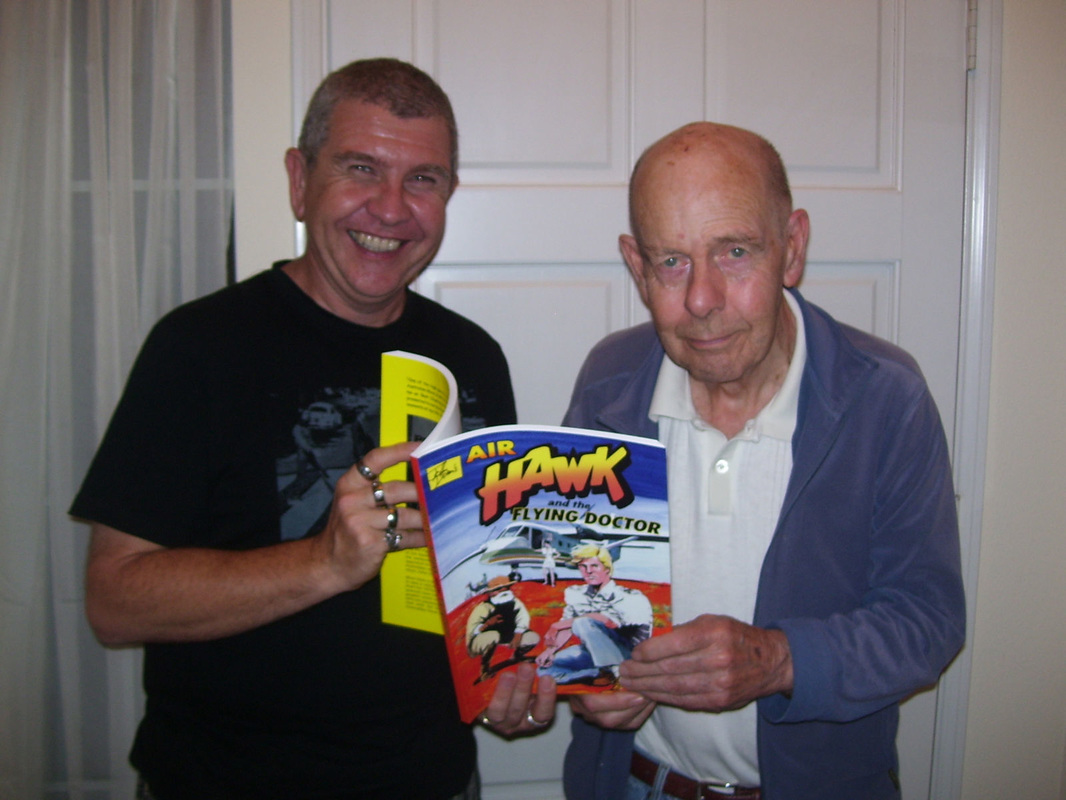 Late July 2011. After many years of letter-writing, faxes, phone calls and emails (not to mention the publishing of six AIR HAWK comics in the late 1980s), I finally met my #1 comic idol, JOHN DIXON for the very first time! Here is one of few photos we took, as I presenting John the book I'd just published. Inside were 5 compete AIR HAWK adventures and (more interesting to John) reflections on his life and work by his family and friends. I have just spoken to John Dixon's nephew, Terry, who has allowed me to make a statement about this world-famous Australian comic book and comic strip writer and illustrator...
On April 18th, John Dixon had a stroke and has not regained consciousness. The nurse attending last Saturday said that John was "in transition and didn't have long to go". He is on medications to keep him comfortable. On behalf of all of the comic fraternity, I'd like to pass on our kind thoughts to his wife Sue, his children Andrew and Jaydi, his sister Sheila and to all his family and close friends during this most difficult time. |
Comicoz is Nat Karmichael's publishing imprint. Nat is committed to preserving a permanent collection of Australian comic and comic strips. He feels that there is a need to recognise comics' contribution to and depiction of Australian culture.
Nat Karmichael.
Since 2011, Nat has self-published over twelve comic-related books and was Publisher-Editor of Oi Oi Oi! -- the last series of nationally-distributed comic books of original stories to appear on Australian newsstands. He is a member of the Australian Cartoonists Association and edited the Association's journal Inkspot for 14 issues from late 2015. He remains the Lead Judge in the Ledger of Honour Awards for the Comic Arts Awards of Australia (formerly the Ledgers). Nat has now retired from his former occupation as a Clinical Nurse in the Psychiatric Emergency Centre in Queensland's largest public hospital, so that he can spend more time with his long-suffering wife and their six children and fourteen grandchildren. He still plans to publish more comics and comic-related books, the details of which you should see here in the coming months... Comicoz acknowledges the Traditional Custodians of Country throughout Australia and their connections to land, sea and community. We pay respects to elders, past, present, and emerging, and extend that respect to all First Nations peoples.
Archives
May 2024
Quick LinksAustralian Publications since 1976:
1 x Poster 19 x comics (one a co-production with Cyclone Comics in 1988/9, one a co-production with Cowtown Comics in 2022) 2 x Paperback books 10 x Hardcover books All Australian! |
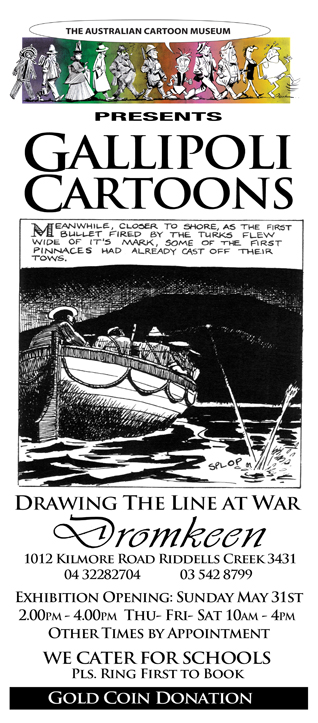
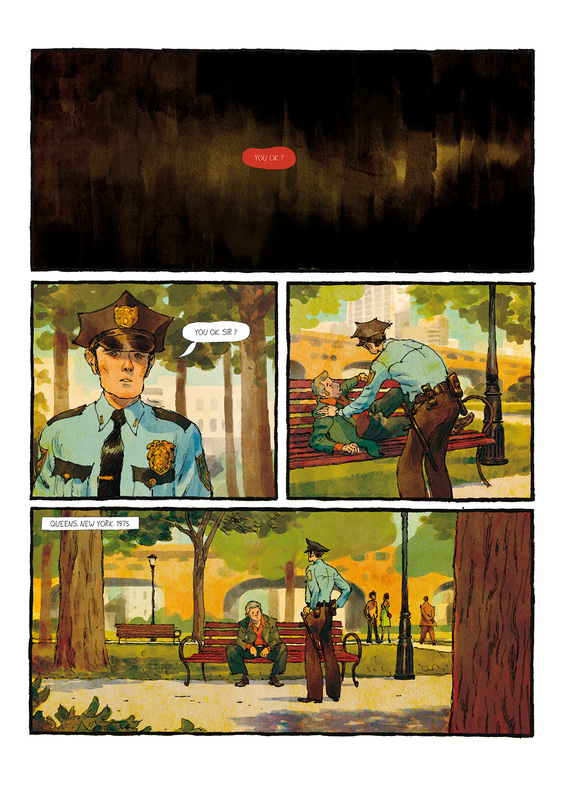
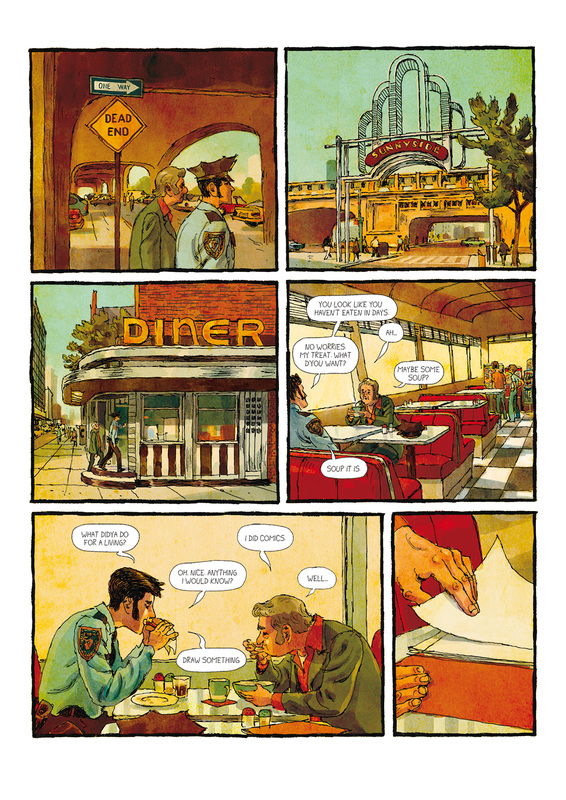
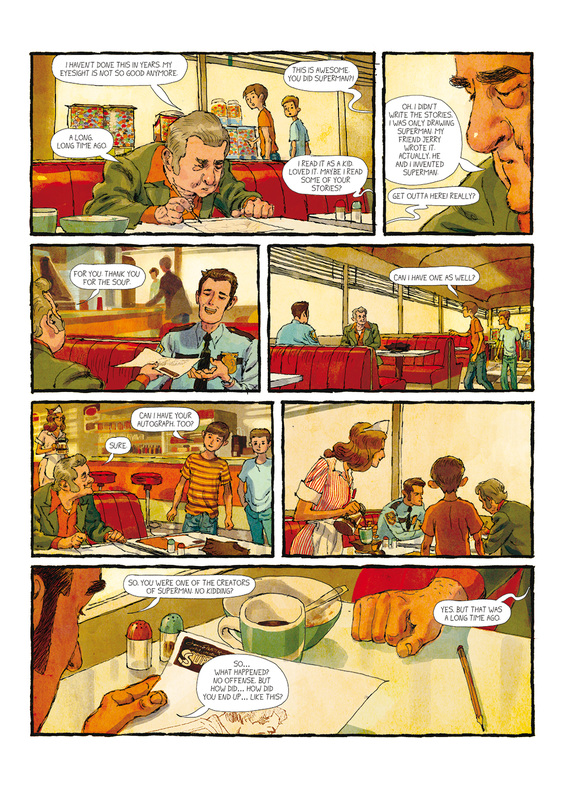
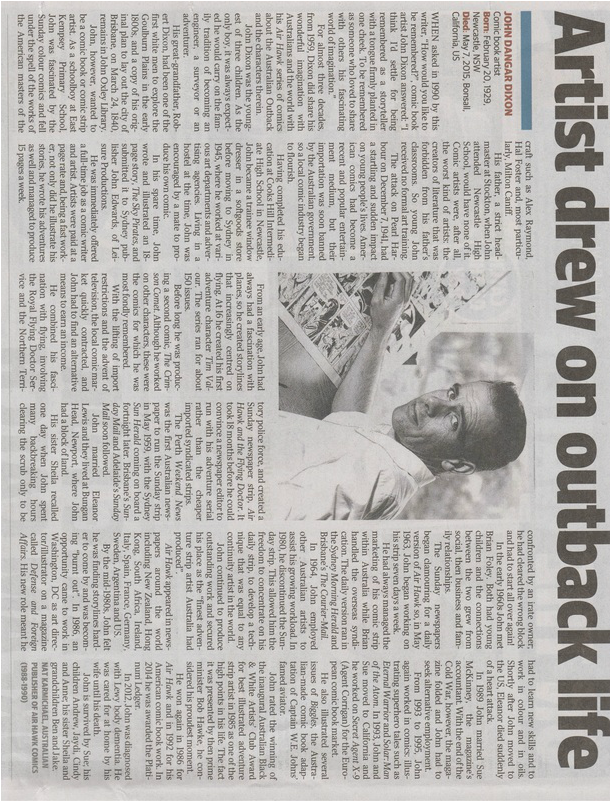
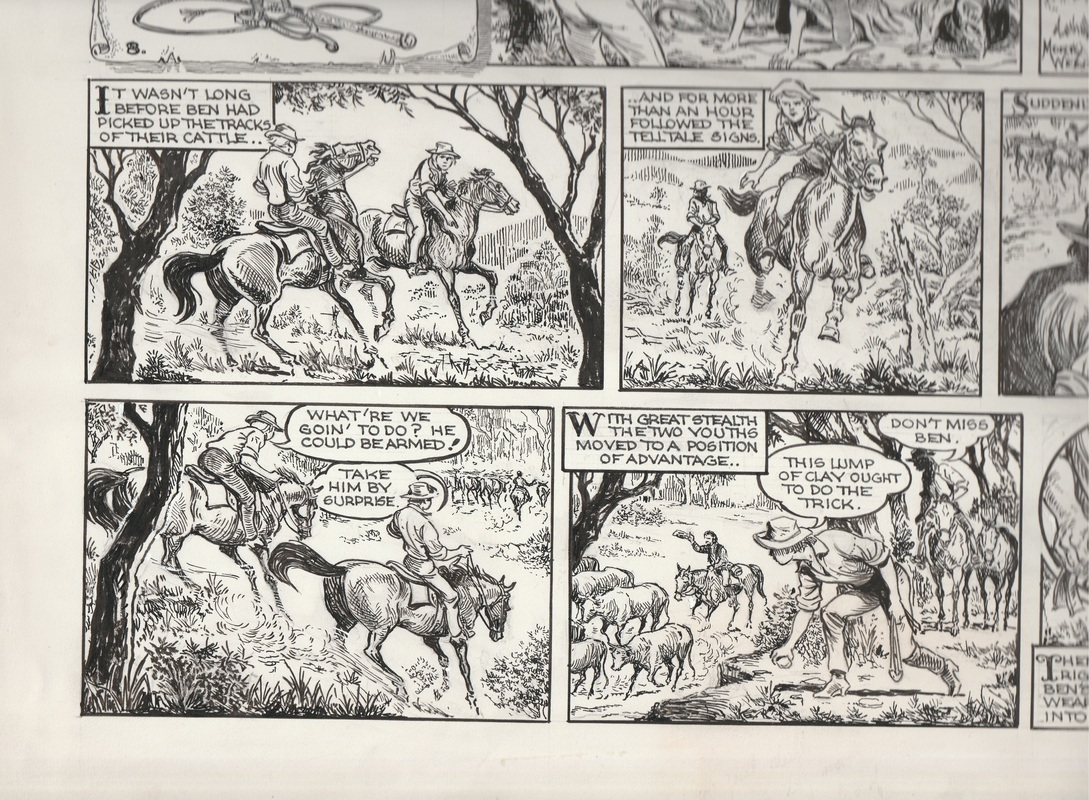
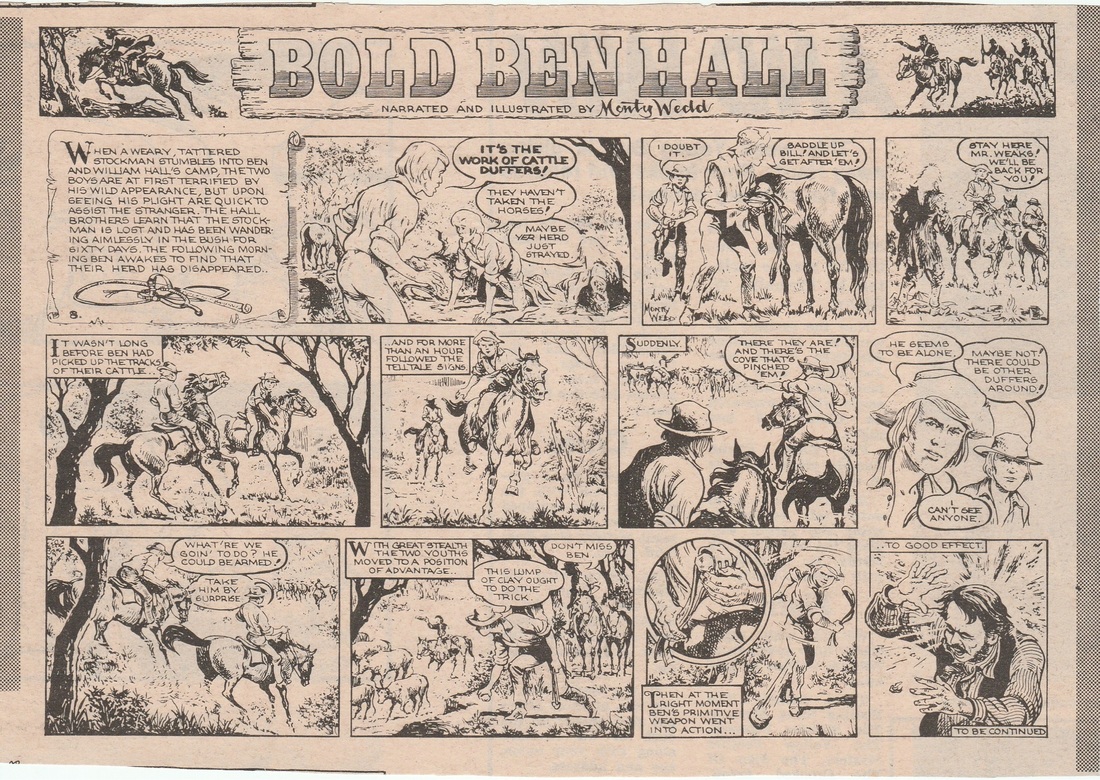
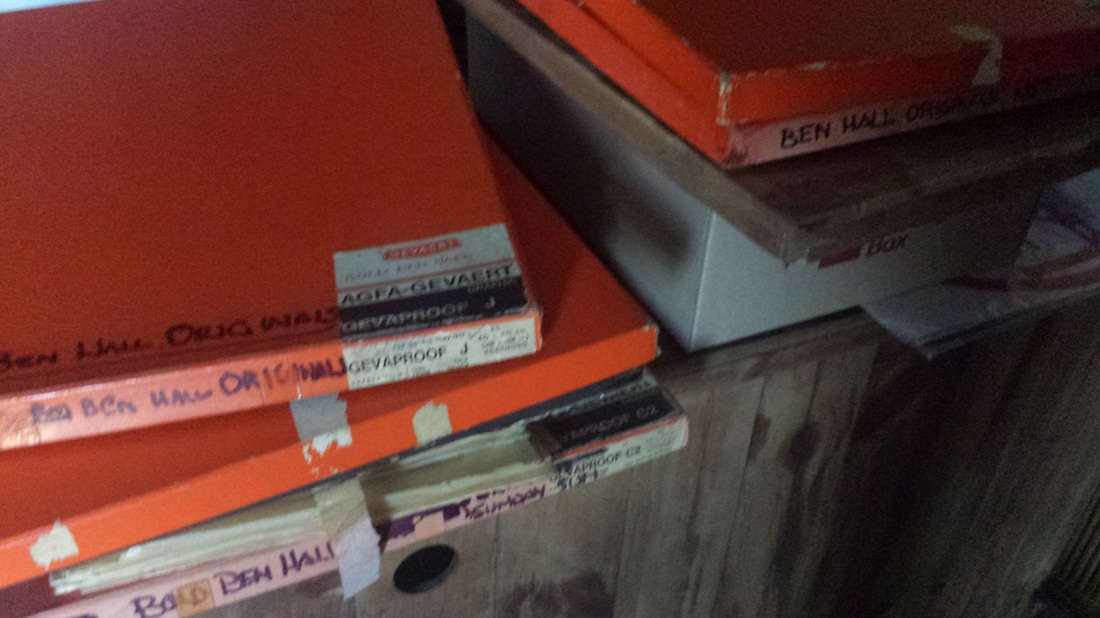
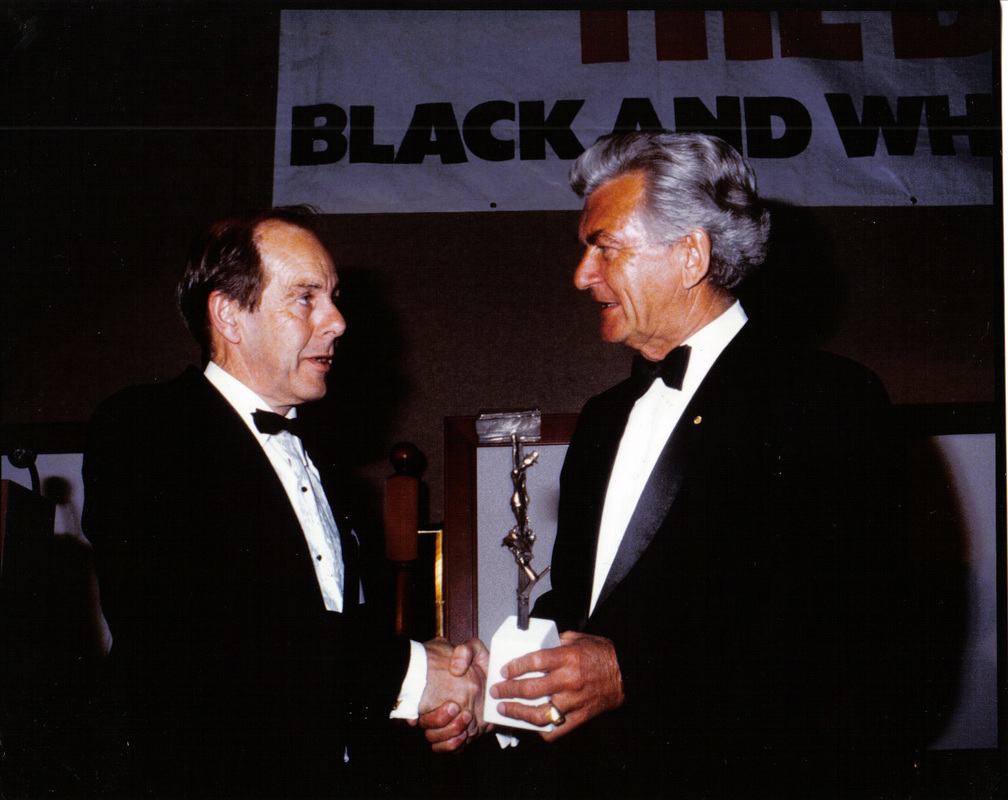
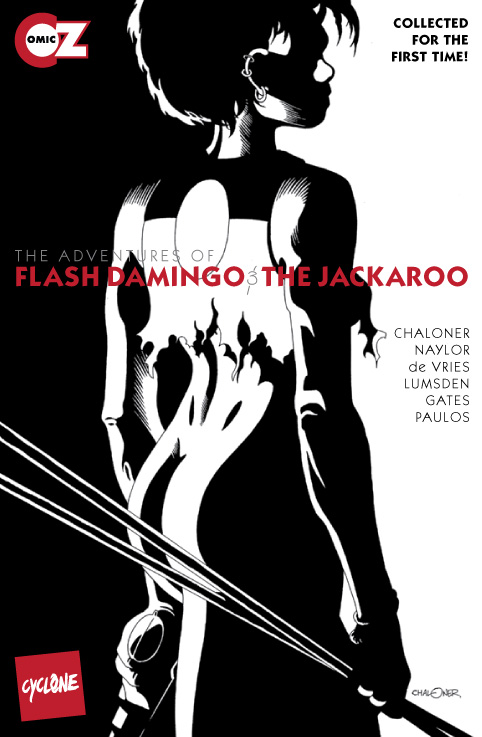

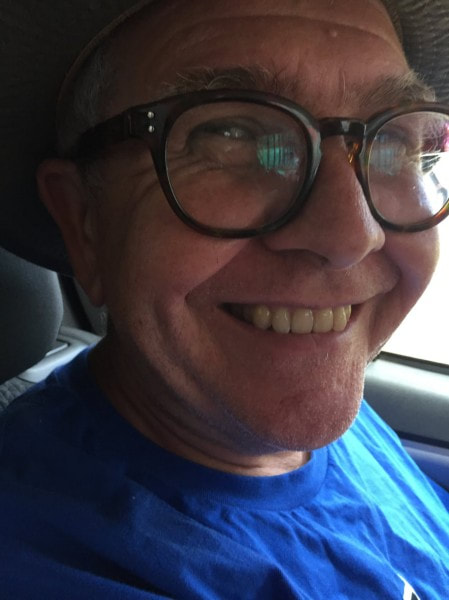
 RSS Feed
RSS Feed
